11 miles and 27 minutes
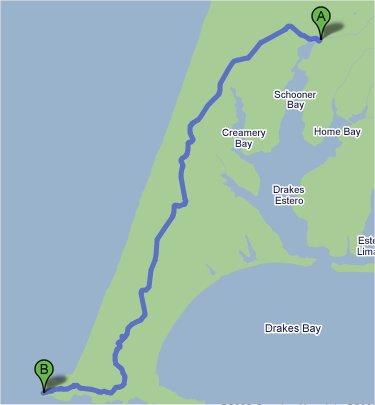

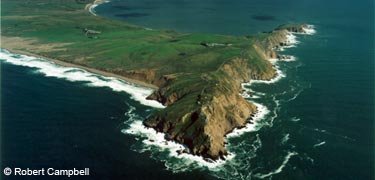 A professionally done photo shows the Point Reyes lighthouse from the sea.
A professionally done photo shows the Point Reyes lighthouse from the sea.
From the oyster farm, we ended up traveling southward along the coastline of the peninsula, arriving at a very small parking lot. Much to our dismay, the parking lot was BELOW a hill, which of course we needed to walk up, before reaching the lighthouse.
Well, not exactly. But, you'll find out more later on.
Thank GOODNESS the walk up the hill was on a paved road. WAIT! You might wonder, "if it was a paved road, why didn't you just DRIVE up?" and that would be a very good question. We wondered that ourselves, especially in light of the fact that we observed a car descending the hill and passing through a gate to the parking area. We asked the occupants of the car if the road was open .. it was .. but only to the handicapped. Now, I have always believed that being an official US taxpayer is handicap enough, but apparently it's Not Enough. We had to walk.
At the very top of the hill is the lighthouse Visitor's Center, where they have an astounding display of a Gray Whale skeleton. Oh. My. Goodness .. this sucker is HUGE. The info on this skeleton is:
California Gray Whale Skull
species: eschrichtius robustus
location found: Vandenburg AFB, California
length: 41 feet
estimated weight: 30-40 tons
cause of death: unknown
date found :1/22/85
sex: female
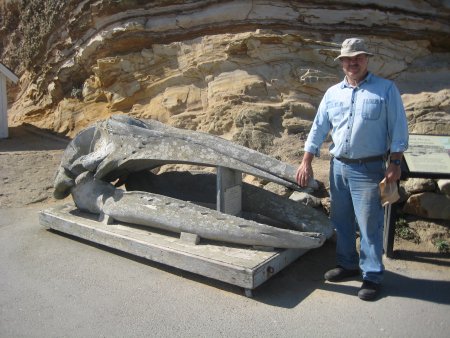 |
Just for scale, I had Mr. Pirate stand next to the whale skull |
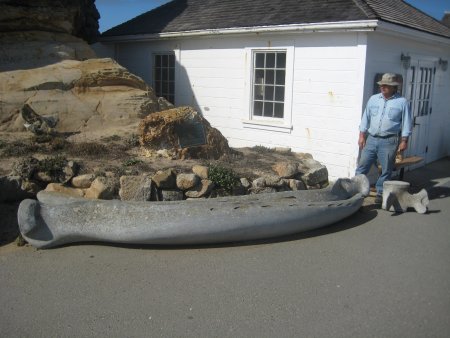 |
and the ribs |
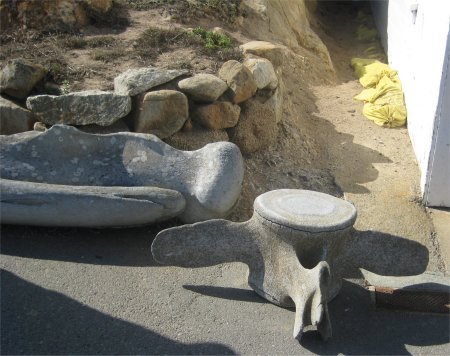 |
and spinal vertebrae. |
Just around the corner from the Visitor's Center is a huge, hunking pile of rocks called (amusingly, to me) the Point Reyes Conglomerate.
From the website, I found this information:
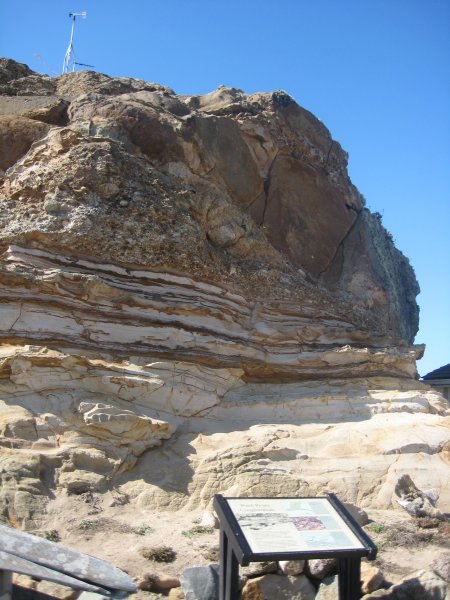
The lighthouse on the Point Reyes headlands is built upon a formation of rock called Point Reyes Conglomerate. This intriguing rock exposure is a part of a formation that caps the highest hills in this area. The Point Reyes Conglomerate rests atop the granite basement. It's a mixture of sand, gravel and pebbles that was laid down on the seafloor between 50 and 60 million years ago and is a sandy matrix embedded with pebbles, cobblestones and boulders.These materials tumbled down the continental slope until it reached the deep seafloor. The rapid motion shaped and sorted the material by size and mass. The large pebbles stopped first, the medium gravel second and finally, the fine grain sands.
You can see layers intersecting at different angles and rounded cavities caused by the erosion of poorly cemented materials.
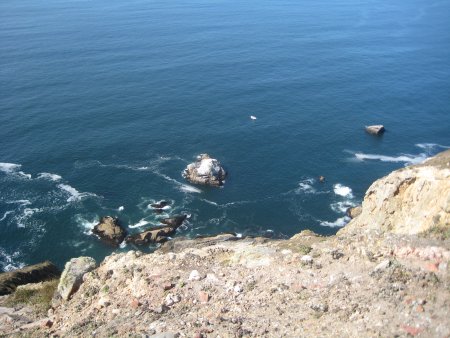 As we rounded the Conglomerate, we reached the viewing platform waaaay above the lighthouse proper. The view from here is spectacular ... this one is straight down the northeastern side of the lighthouse. It was an incredibly dizzying sight. Also on the platform was another warning sign.
As we rounded the Conglomerate, we reached the viewing platform waaaay above the lighthouse proper. The view from here is spectacular ... this one is straight down the northeastern side of the lighthouse. It was an incredibly dizzying sight. Also on the platform was another warning sign.
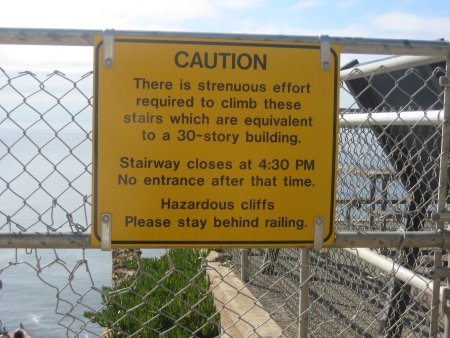
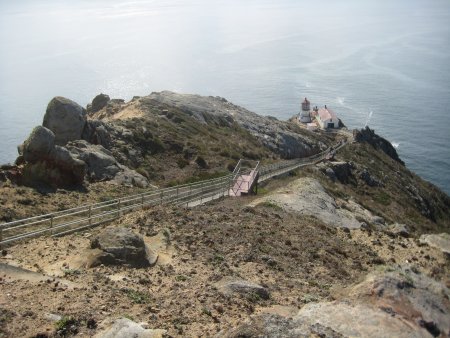 Oh. My. Goodness. MORE CLIMBING?l!??! Let's look at that one more time ....down then up AGAIN? You've really got to be kidding. Hasn't anyone in the government heard of elevators? At the very least, escalators? Having come fresh from the Sands of Kehoe Beach and, more recently, the walk UP to the lighthouse, neither Mr. Pirate nor I felt the slightest inclination to climb another mountain. Maybe down ONLY, but up as well? No way, Josť.
Oh. My. Goodness. MORE CLIMBING?l!??! Let's look at that one more time ....down then up AGAIN? You've really got to be kidding. Hasn't anyone in the government heard of elevators? At the very least, escalators? Having come fresh from the Sands of Kehoe Beach and, more recently, the walk UP to the lighthouse, neither Mr. Pirate nor I felt the slightest inclination to climb another mountain. Maybe down ONLY, but up as well? No way, Josť.
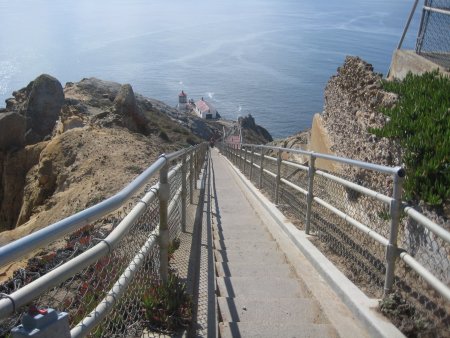
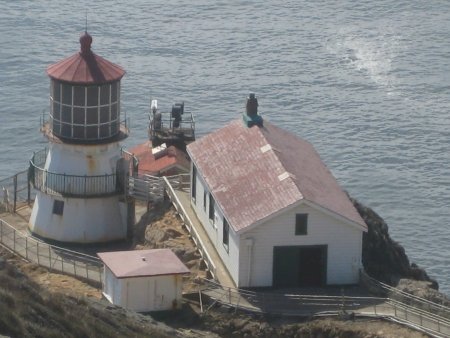 From the vantage of the viewing platform, I zoomed in on the lighthouse, which was as close as we were ever going to get to that structure. And no, I do NOT regret not going down then back UP those stairs! The information about the lighthouse was posted on the platform for us wusses who chickened out. :-)
From the vantage of the viewing platform, I zoomed in on the lighthouse, which was as close as we were ever going to get to that structure. And no, I do NOT regret not going down then back UP those stairs! The information about the lighthouse was posted on the platform for us wusses who chickened out. :-)
Point Reyes Light
Weather permitting, you may visit the historic lighthouse via the stairway to your left. Be prepared for a steep return up more than 300 steps.
At sundown, a lightkeeper lit the wick of an oil lamp that set inside the lens. 1,032 dazzling prisms directed a beam to the horizon. An exquisite brass clockwork rotated the lens to give the appearance of a flashing light. The mechanism still works. Until 1929, the fog signal occupied a niche well below the lighthouse. During foggy spells, a steam whistle on the roof blew once a minute. Lightkeepers stoked the boilers with 140 lbs of coal per hour.
Point Reyes Light has guided and cautioned mariners along this hazardous coast for over 100 years. Built by the US Lighthouse Service in 1870, it came under management of the US Coast Guard in 1939. Resident personnel operated the station until 1975 when the conversion to automated lights and electronic equipment was completed.